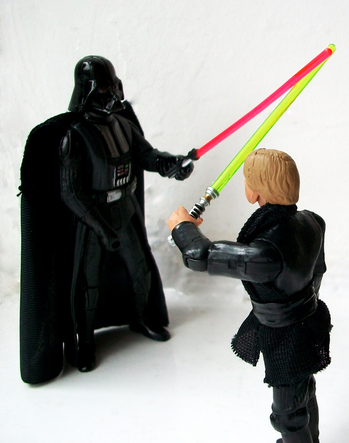A prosthetic hand better than Luke Skywalker's? Researcher says it's possible

Photo courtesy of Flickr Commons
Luke got a bionic hand later in "Star Wars Episode V: The Empire Strikes Back."
Far-fetched? Maybe not.
A University of Michigan researcher says he’s developing something even better for amputees who’ve lost the all-important important human extremity.
In the future, users of a real-life bionic hand could be able to control it in much the same way they would control a human hand. But unlike Luke’s, it will also be able to feel, said Paul Cederna, plastic surgery professor and associate surgery chief at the University of Michigan Health System.
Cederna said prosthetic hands have been around for a long time, and many recipients still like to use a hook. There are high-tech devices out there, too, he said, various incarnations of mechanical hands.
“But there’s no great way to control them to provide fine digital dexterity. “
He's talking about the kind of dexterity that would allow a person to stretch the prosthetic hand, or play the piano, or type on a keyboard. That would require interface between the brain’s peripheral nerve signals, which carry the brain's instructions on how to move, and the prosthetic device. And then to feel, sensory nerves in the prosthetic hand would need to communicate messages back to the brain so that it could recognize feelings like warmth associated with a loved one's face, a light touch or a pin prick, Cederna said.
Amputees still have all the nerves in their residual limb that carry the same information they used to carry. That information stops where the amputation begins.
In Cederna’s hand, signals coming down a nerve assigning an action to move a thumb would be fed to a prosthesis, which would then move its thumb. And because researchers plan to perfect the interface by regenerating muscle, instead of bothering the nerve, the idea is the hand would be good for long-term use, say 60 years or so.

Flickr Commons photo
He hopes to move the research to human trials in the next three years. Now, researchers are studying and monitoring signals from the peripheral nerves in rats and decoding them, so those signals would be ready to feed to a prosthesis if the rat had one.
Cederna’s research is being funded by the Department of Defense, which is also responsible for taking care of active duty personnel who have lost limbs in combat situations. The Army Research Office is also providing funding. If he proves in animal trials that the project has long term sustainability, more federal funding could come his way.
Juliana Keeping is a health and environment reporter for AnnArbor.com. Reach her at julianakeeping@annarbor.com or 734-623-2528. Follow Juliana Keeping on Twitter


Comments
Otho
Fri, Nov 12, 2010 : 1:43 p.m.
I don't see anything here that shows how this bionic hand will be "better" than Luke Skywalker's!
Plubius
Fri, Nov 12, 2010 : 8:59 a.m.
Two comments: 1 - Based on what has been reported here, there is nothing particularly novel about the research, except that it is being led by a medical doc, not en engineer (which significantly lowers the projects' chance of success). 2 - The number of upper extremity amputees is so small that any business formed around this technology will never be funded because the market opportunity is just too small.
RudeJude
Thu, Nov 11, 2010 : 4:19 p.m.
"Luke, our technology is outdated." "Noooooooooooooooooo!"